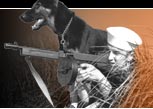
















 |
 |
 |
 |
 |
 |
 |
 |
 |
 |
 |
|
 |
|||||||
 |
 |
 |
|||||||
 |
|
|
|
|
 |
||||
| Choose one: Virginia's Coastal Defense | Art Mack Story |
|
| |
| Virginia's Atlantic coast extends for hundreds of miles and includes dozens of barrier islands, as well as the opening to the Chesapeake Bay. All of it needed protection in the war. The most likely threat to Virginia's coast and its shipping were German U-Boats. In early 1942 German U-Boats crept along the Virginia coast and targeted Allied ships. Civilians patrolled beaches and manned watch towers to spot U-Boats. They watched the skies for German aircraft and worked to achieve total blackouts in the major cities. Blackouts made Allied ships more difficult for German U-Boats to find-without shore lights on the horizon to silhouette them. This exhibit features the many elements of coastal defense in World War II Virginia. | |
|
|
|||||||||||||||||||
|
|
|||||||||||||||||||
|
|
|||||||||||||||||||
|
|
|||||||||||||||||||
|
|
|||||||||||||||||||
|
|
|||||||||||||||||||
|
|
|||||||||||||||||||
|
|
|||||||||||||||||||
|
|
|||||||||||||||||||
|
 |
||||||||||
|
| Arthur W. Mack was born in New York in 1920. He enlisted in the National
Guard, and was taken into federal service in the Army in 1941 and was sent
to Norfolk. He met a civilian Army typist from North Carolina named Tess
and courted her while they were both stationed in Norfolk. They married on
June 20, 1942. In 1942 he applied at Langley to be taken into pilot
training, and was accepted.
Mack ended up as a captain of a B-17 (with a crew of ten) in the 306th Bomber Group, and flew 25 missions from England over Germany. He won the Distinguished Flying Cross in 1944 for safely bringing a heavily damaged B-17 back from a bombing run over Germany. Mack's heroic safe return was widely covered in the newspapers. This exhibit features the personal collection of Art Mack's photographs from the war. |
|
|
|
|||||||||||||||||||
|
|
|||||||||||||||||||
|
|
|||||||||||||||||||
|
|
|||||||||||||||||||
|
|
|||||||||||||||||||
|
|
|||||||||||||||||||
|
|
|||||||||||||||||||
|
|
|||||||||||||||||||
| To view the entire collection of Art Mack images, click here. |
 |
||||
 |
|
|
|
|